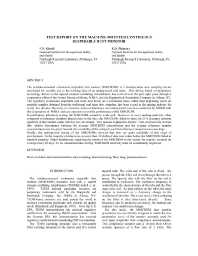Mining Publication: Test Report on the Machine-Mounted Continuous Respirable Dust Monitor
Original creation date: June 2001
The machine-mounted continuous respirable dust monitor (MMCRDM) is a fixed-location area sampling device developed for possible use at the working face of an underground coal mine. This device, based on proprietary technology known as the tapered element oscillating microbalance, has evolved over the past eight years through a cooperative effort of the former Bureau of Mines, MSHA, and the Rupprecht and Patashnick Company in Albany, NY. The capability to measure respirable coal mine dust levels on a continuous basis, rather than depending solely on periodic samples obtained from the traditional coal mine dust samplers, has been a goal in the mining industry for nearly two decades. Recently, an extensive series of laboratory and underground tests was conducted by NIOSH with the cooperation of MSHA and coal operators to test the performance of the MMCRDM.
Authors: FN Kissell, ED Thimons
Conference Paper - June 2001
NIOSHTIC2 Number: 20021356
Proc Seventh International Mine Ventilation Congress, 2001, (17-22 June: EMAG 2001, Krakow, Poland); :253-260
See Also
- Benchmarking Longwall Dust Control Technology and Practices
- Determining the Spatial Variability of Personal Sampler Inlet Locations
- Differential Pressure Response of 25-mm-Diameter Glass Fiber Filters Challenged with Coal and Limestone Dust Mixtures
- Equivalency of a Personal Dust Monitor to the Current United States Coal Mine Respirable Dust Sampler
- Evaluation of LIDAR as a Novel Remote Dust Sensing Technology
- Evaluation of the Approach to Respirable Quartz Exposure Control in U.S. Coal Mines
- Respirable Quartz Hazard Associated with Coal Mine Roof Bolter Dust
- Rock Dusting Considerations in Underground Coal Mines
- Status of a Tapered Element, Oscillation Microbalance-Based Continuous Respirable Coal Mine Dust Monitor
- Technology News 463 - Machine-Mounted Continuous Respirable Dust Monitor
- Page last reviewed: 9/21/2012
- Page last updated: 9/21/2012
- Content source: National Institute for Occupational Safety and Health, Mining Program


 ShareCompartir
ShareCompartir
